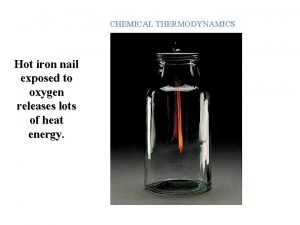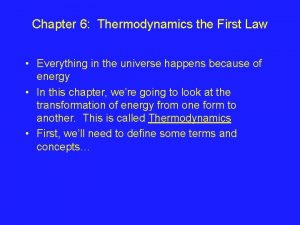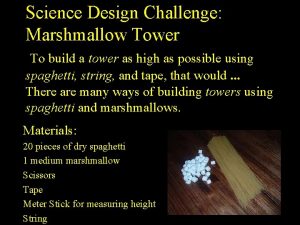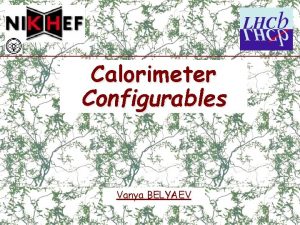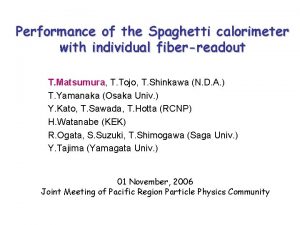Spaghetti calorimeter A reminder of the calorimeter design







- Slides: 7

Spaghetti calorimeter A reminder of the calorimeter design: from L. T. ’s presentation at CERN on 29/03/03 Readout: square (or rectangular) cells connected to PMT photocatode by light guides shaped as Winston cones

Muon vs electron identification We have carried out simulation studies in G 4 MICE to optimize the m/e separation capabilities by varying: § sampling fraction, i. e. lead layer thickness: 0. 5 -0. 2 mm § readout segmentation, i. e. cell size: 3. 75 x 3. 75 cm 2, 3. 25 x 3. 25 cm 2, 2. 5 x 2. 5 cm 2, 2. 5 x 4. 0 cm 2

Momentum muons at production electrons at calorimeter (20% lost) (0. 5% <130 Me. V/c) Muons P(Me. V/C) Datacards used: <Ekin>=120. 5 Me. V , DE/E=0. 1

Lead absorber Eff. for signal>threshold in 3 rd or 4 th layer vsmomentum (useful mainly for trigger purposes) For different absorber thickness and readout cell sizes Eff. In Layer 3 Eff. In Layer 4 Efficiency on muons improves when less material is traversed (thinner layers, smaller cells), but electron contamination increases accordingly

A much lighter absorber: pure polystirene • The option of a fully active detector (scintillator) has been suggested • We have considered the option with no absorber: only polystirene fibers è Efficiencies are very optimistic !!!! è Readout with 3. 75 cm cells = a huge number of PMTs

e/m separation algorithms: Baricenter coordinate cells 3. 75 cm electrons muons ZB (a. u. ) cells 2. 50 cm ZB (a. u. )

Summary • Some checks to be done on beam distributions obtained with G 4 MICE • Optimization: 1) for fast signal (threshold cut) – Better efficiency on muons with thinner lead layers – No significant gain on low energy muons with fully active detectors, but much larger contamination from electrons 2) e/m identification – Baricenter coordinate seems to be a very good separation criterium – Improving with thicker absorber and smaller redout cells, but to be checked as a function of muon momentum – Fully active detector provides very poor identification capabilities





